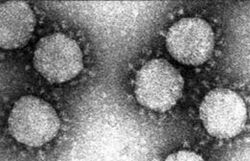Biology:Alphacoronavirus 1
| Alphacoronavirus 1 | |
|---|---|

| |
| Electron micrograph of Alphacoronavirus 1 of pig (transmissible gastroenteritis coronavirus) | |
| Virus classification | |
| (unranked): | Virus |
| Realm: | Riboviria |
| Kingdom: | Orthornavirae |
| Phylum: | Pisuviricota |
| Class: | Pisoniviricetes |
| Order: | Nidovirales |
| Family: | Coronaviridae |
| Genus: | Alphacoronavirus |
| Subgenus: | Tegacovirus |
| Species: | Alphacoronavirus 1
|
| Member viruses[1] | |
Alphacoronavirus 1 is a species of coronavirus that infects cats, dogs and pigs. It includes the virus strains feline coronavirus, canine coronavirus, and transmissible gastroenteritis virus.[1] It is an enveloped, positive-strand RNA virus which is able to enter its host cell by binding to the APN receptor.[2]
Member viruses were first recognised as viruses that caused transmissible gastroenteritis in pigs in 1965. It was originally named porcine transmissible gastroenteritis virus in 1976. After subsequent discovery of canine coronavirus in dogs and feline coronavirus in cats, the three virus species were merged into a single species in 2009. The strain canine coronavirus-HuPn-2018 has been identified in a small number of human cases.
Discovery
In the mid-1940s there was an outbreak of pig disease in US, called transmissible gastroenteritis, which was characterised mainly by diarrhoea and vomiting. It was suspected to be a viral infection and was highly fatal among young pigs. Leo P. Doyle and L. M. Hutchings reported the case in the Journal of the American Veterinary Medical Association in 1946.[3] The virus was identified and isolated by A. W. McClurkin in 1965.[4] The International Committee for the Nomenclature of Viruses (ICNV, later renamed International Committee on Taxonomy of Viruses, ICTV, in 1975) accepted the scientific named Transmissible gastro-enteritis virus of swine in its first report in 1971, but renamed it Porcine transmissible gastroenteritis virus (PTGV) in its second report in 1976.[1]
There was another case of coronavirus infection in cats in 1966. The virus caused inflammation of the abdomen (peritonitis) and was highly fatal.[5] The virus was identified in 1968,[6] and was named as Feline infectious peritonitis virus by ICTV in 1991. It was again renamed Feline coronavirus in 1999.[7] In 1974 there was an outbreak of viral infection among US military dogs.[8] The virus was identified as a coronavirus and the formal name Canine coronavirus was adopted by ICTV in 1991. As the molecular and antigenic relationship of the three viruses were later established in the late 1980s,[9][10] ICTV merged them into a single species Alphacoronavirus 1 in 2009.[1]
References
- ↑ 1.0 1.1 1.2 1.3 "ICTV Taxonomy history: Alphacoronavirus 1" (in en). https://talk.ictvonline.org/taxonomy/p/taxonomy-history?taxnode_id=201901849.
- ↑ "Coronaviruses: an overview of their replication and pathogenesis". Coronaviruses. Methods in Molecular Biology. 1282. Springer. 2015. pp. 1–23. doi:10.1007/978-1-4939-2438-7_1. ISBN 978-1-4939-2438-7. "See Table 1."
- ↑ Doyle, L. P.; Hutchings, L. M. (1946). "A transmissible gastroenteritis in pigs". Journal of the American Veterinary Medical Association 108: 257–259. PMID 21020443. https://www.ncbi.nlm.nih.gov/pubmed/21020443.
- ↑ Mcclurkin, A. W. (1965). "Studies on transmissible gastroenteritis of swine I. The isolation and identification of a cytopathogenic virus of transmissible gastroenteritis in primary swine kidney cell cultures". Canadian Journal of Comparative Medicine and Veterinary Science 29: 46–53. PMID 14290945.
- ↑ Wolfe, L.G.; Griesemer, R.A. (1966). "Feline infectious peritonitis" (in en). Pathologia Veterinaria 3 (3): 255–270. doi:10.1177/030098586600300309. PMID 5958991. http://journals.sagepub.com/doi/10.1177/030098586600300309.
- ↑ Zook, B. C.; King, N. W.; Robison, R. L.; McCombs, H. L. (1968). "Ultrastructural evidence for the viral etiology of feline infectious peritonitis" (in en). Pathologia Veterinaria 5 (1): 91–95. doi:10.1177/030098586800500112. http://journals.sagepub.com/doi/10.1177/030098586800500112.
- ↑ "ICTV Taxonomy history: Feline infectious peritonitis virus" (in en). https://talk.ictvonline.org/taxonomy/p/taxonomy-history?taxnode_id=19980734&taxa_name=Feline%20infectious%20peritonitis%20virus.
- ↑ Binn, L. N.; Lazar, E. C.; Keenan, K. P.; Huxsoll, D. L.; Marchwicki, R. H.; Strano, A. J. (1974). "Recovery and characterization of a coronavirus from military dogs with diarrhea". Proceedings, Annual Meeting of the United States Animal Health Association (78): 359–366. PMID 4377955. https://www.ncbi.nlm.nih.gov/pubmed/4377955.
- ↑ Jacobs, L.; de Groot, R.; van der Zeijst, B. A.; Horzinek, M. C.; Spaan, W. (1987). "The nucleotide sequence of the peplomer gene of porcine transmissible gastroenteritis virus (TGEV): comparison with the sequence of the peplomer protein of feline infectious peritonitis virus (FIPV)". Virus Research 8 (4): 363–371. doi:10.1016/0168-1702(87)90008-6. PMID 2829461.
- ↑ Hohdatsu, T.; Okada, S.; Koyama, H. (1991). "Characterization of monoclonal antibodies against feline infectious peritonitis virus type II and antigenic relationship between feline, porcine, and canine coronaviruses". Archives of Virology 117 (1–2): 85–95. doi:10.1007/BF01310494. PMID 1706593.
Wikidata ☰ Q18965331 entry

